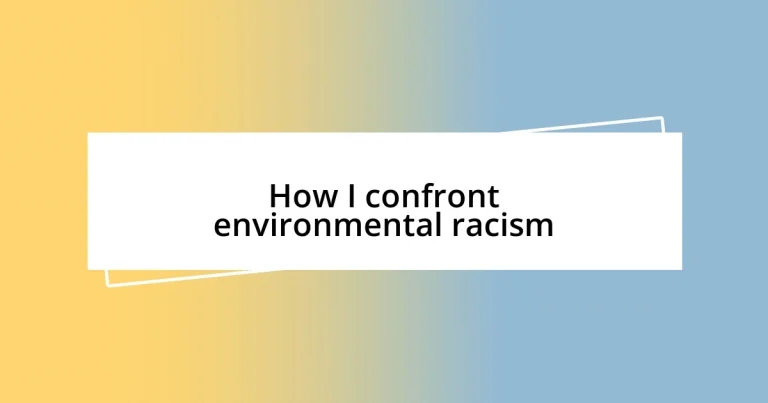Key takeaways:
- Environmental racism disproportionately affects communities of color, leading to health crises and limited access to clean resources.
- Engaging in community advocacy and supporting local organizations fosters unity, empowerment, and meaningful change against environmental injustices.
- Participating in policy change efforts and fostering long-term partnerships with communities enhances trust, collaboration, and resilience in addressing environmental issues.
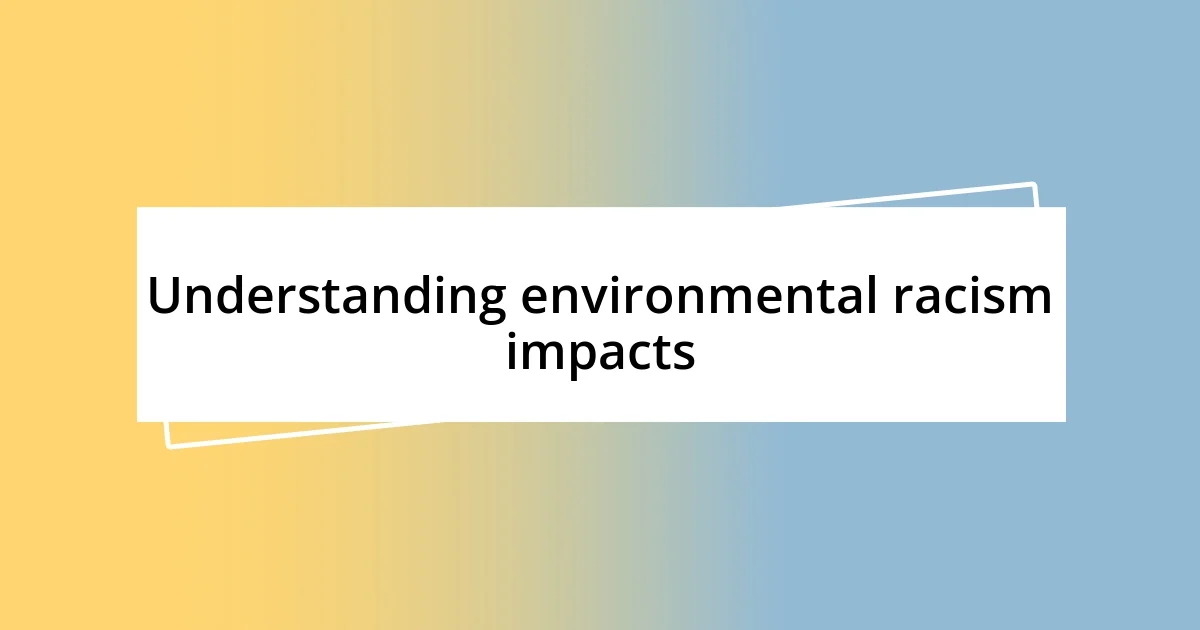
Understanding environmental racism impacts
Environmental racism manifests in real, tangible ways that profoundly affect communities of color. I remember visiting a neighborhood where families expressed deep concern about the air quality due to a nearby industrial plant. Can you imagine raising children in a place where you worry about their breathing every day? The emotional weight of that stress is something that sticks with you.
The disparities are not just about location; they can also lead to health crises. In that same community, I learned about higher rates of asthma among children compared to wealthier, predominantly white neighborhoods. It’s heartbreaking to consider that these health outcomes stem from decisions made without the input or consideration of those who live there. Why should anyone have to bear the brunt of pollution simply because of where they live?
Furthermore, I’ve seen how these environmental injustices extend beyond health. Access to clean water or safe public spaces can be limited in marginalized communities. I often question how we can stand by while systemic issues deny people the right to a healthy environment. It’s a cycle that perpetuates poverty and suffering, and recognizing these impacts is the first step toward meaningful change.
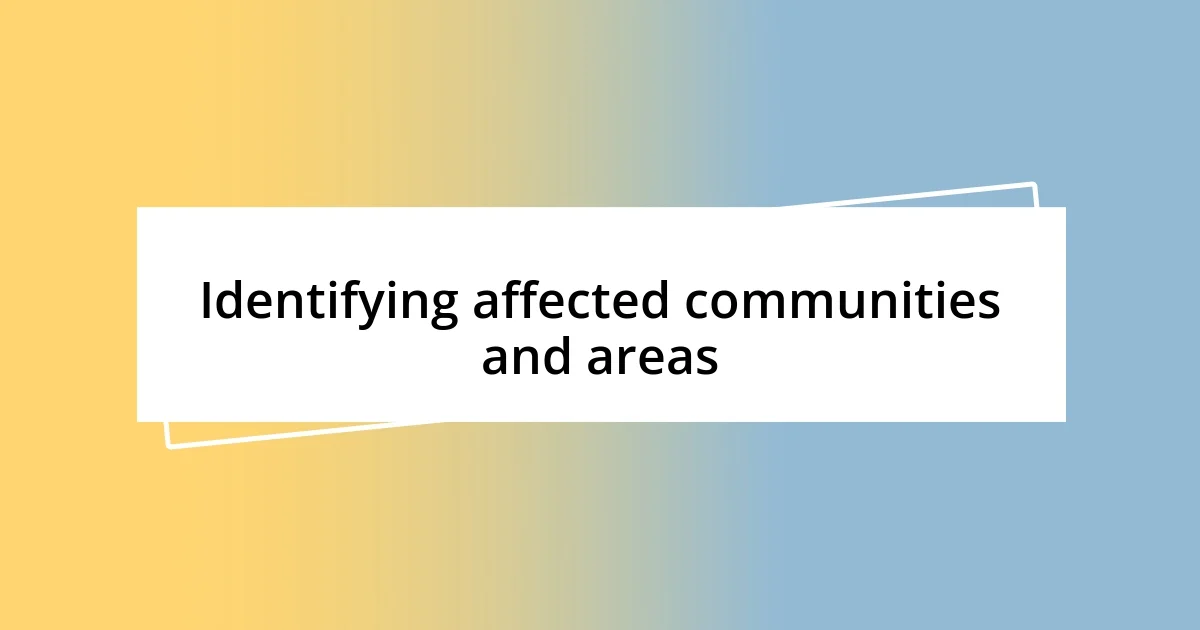
Identifying affected communities and areas
Identifying affected communities and areas begins with recognizing the patterns of inequality embedded in our environment. I recall driving through a neighborhood that was strikingly different from mine. While my area had lush parks and clean streets, this community was dotted with dilapidated facilities, all under the shadow of factories. Suddenly, it became clear how geography plays a role in the lived experiences of these residents.
Moreover, it’s essential to analyze demographic data to paint a clearer picture of who is affected. I once reviewed reports that highlighted how predominantly Black and Latino communities faced a disproportionate burden of toxic waste sites. It struck me that, in so many cases, these residents were simply fighting to protect their homes and families. Their voices, however, are often drowned out by industrial interests. Can we really call ourselves a fair society when these disparities exist?
Finally, community forums often serve as crucial spaces for identifying these environmental injustices. During one such meeting, I listened to residents, their stories reflecting a shared disappointment in being unheard. Many expressed frustration not just at the pollution but at being overlooked. It was a poignant reminder that engagement is vital. We must listen to those directly impacted to recognize the fullness of their struggles and stand with them in solidarity.
| Identifying Actions | Description |
|---|---|
| Community Surveys | Gathering firsthand accounts and experiences of residents to understand their concerns. |
| Demographic Analysis | Examining socio-economic and racial data to identify affected populations. |
| Health Impact Studies | Researching health outcomes in specific communities to highlight disparities. |
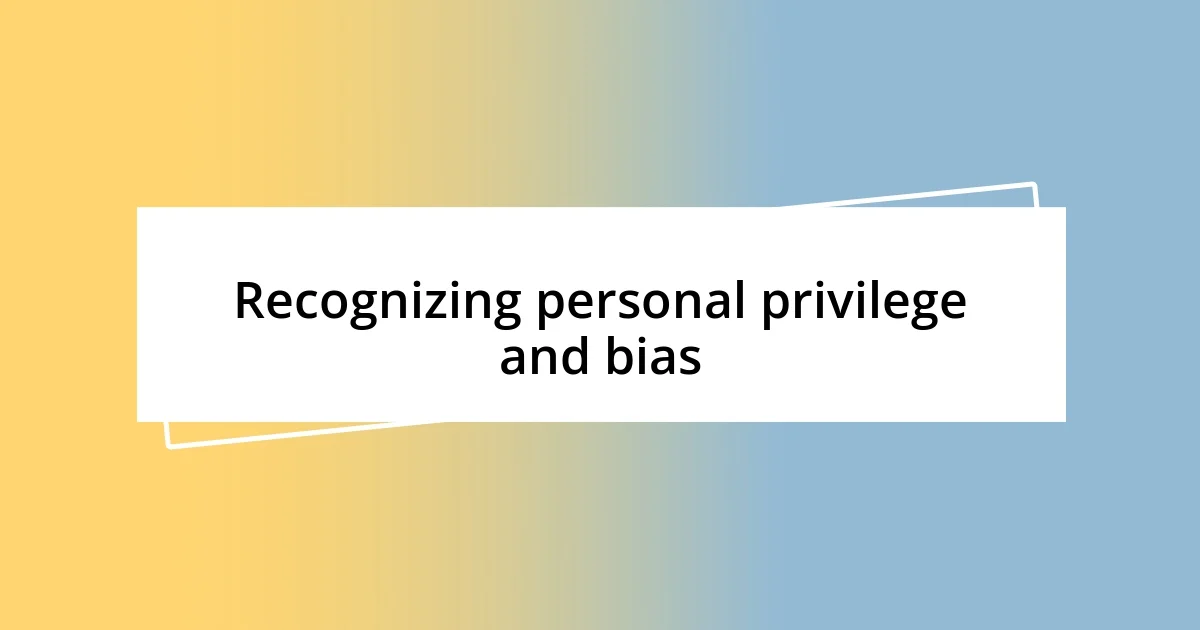
Recognizing personal privilege and bias
Recognizing personal privilege and bias is a critical and often uncomfortable step in confronting environmental racism. I recall a time when I attended a community meeting about pollution regulations, feeling informed and prepared to voice my opinions. However, I soon realized that the very access I had to information and advocacy resources starkly contrasted with those in the room who struggled against systemic barriers every day. It was a humbling experience, showcasing my privilege and reminding me that acknowledging it is essential to authentically support others.
When reflecting on personal privilege and bias, I often find it helpful to consider these points:
- Access to Resources: I grew up in a community with resources that allowed for advocacy efforts, unlike the struggles faced by marginalized neighborhoods.
- Environmental Conditions: My past experiences have been largely free from the fears of toxic exposure and health crises that others confront daily.
- Engagement Opportunities: I have been afforded the chance to participate in conversations and decision-making processes that others are systematically excluded from.
These realizations urge me to take responsibility and listen more actively, ensuring that my position is used to uplift the voices of those who are often silenced.
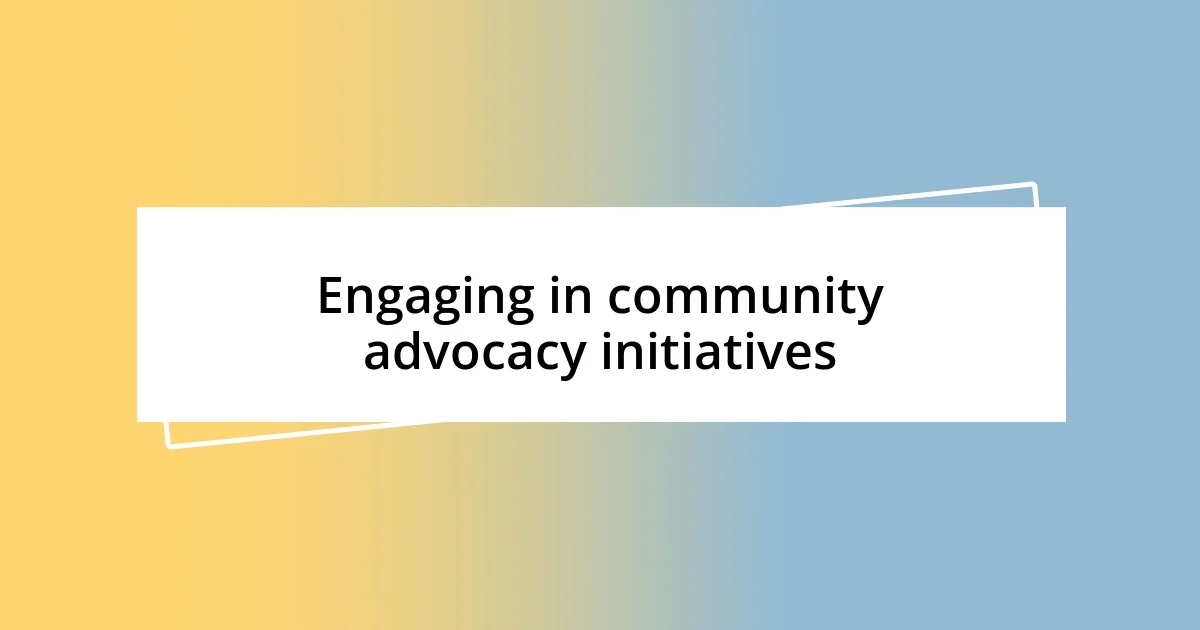
Engaging in community advocacy initiatives
Engaging in community advocacy initiatives can be incredibly empowering, both for individuals and the communities they support. I remember volunteering at a local clean-up event one sunny Saturday morning. What struck me was the sense of unity that emerged as residents came together, wielding trash bags and determination. It made me wonder: how often do we underestimate the impact of these small acts of collective action? Each piece of litter we picked up felt like a step toward reclaiming the community’s health and dignity.
In my experience, collaborating with local organizations can amplify the voice of those facing environmental challenges. For instance, I once worked alongside a grassroots group that sought to address a toxic waste facility nearby. The rapport built over shared dinners and planning sessions was palpable, almost electric. People began to share their stories of hardship, transforming from passive bystanders to empowered advocates. It left me thinking about the connection between personal stories and tangible change — when we uplift each other’s voices, we create a powerful narrative that demands attention.
When I reflect on community advocacy, I can’t help but ask: how can we truly drive change unless we include everyone? I attended a town hall meeting that illustrated this beautifully. Diverse residents voiced their concerns, but the real magic happened when they brainstormed solutions together. Witnessing different perspectives come together acted as a reminder that advocacy isn’t just about fighting against injustice; it’s about building a community of allyship and support. It’s incredible how collective efforts can lead to real conversations with decision-makers, giving communities the chance to reclaim their narrative.
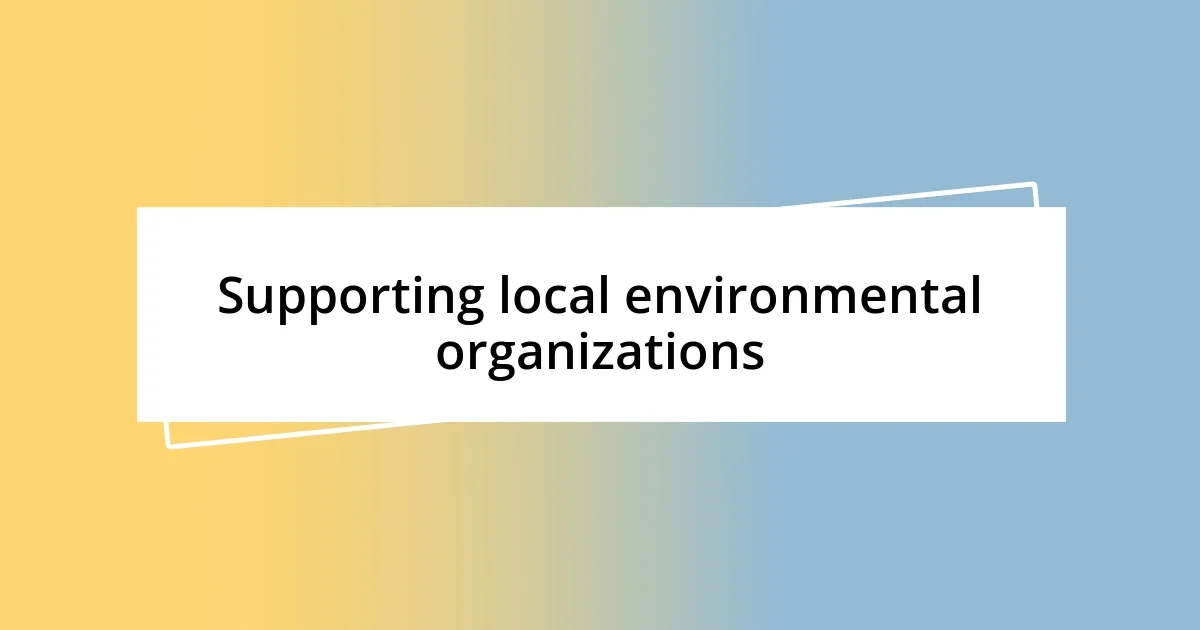
Supporting local environmental organizations
Supporting local environmental organizations has been a game-changer in my journey to confront environmental racism. I remember the first time I attended a fundraiser for a local group focused on clean water access. As I mingled with enthusiastic supporters, I felt an electric sense of purpose in the room. It dawned on me how essential these organizations are in not only advocating for immediate needs but also in educating the community about the systemic issues behind environmental injustices.
While volunteering at a community garden established by a local environmental organization, I truly learned the power of grassroots movements. Every seed planted was more than just a botanical effort; it was a symbolic stand against the food deserts that many in our neighborhoods face. It made me think: how often do we underestimate the strength of nurturing local efforts? Each interaction with families who participated was a reminder that community-led initiatives foster resilience and self-determination.
Engaging with these organizations has taught me that our support goes beyond just monetary contributions. I recall a workshop I attended where community members shared their challenges in accessing environmental resources. Listening to their firsthand experiences reinforced my belief in the importance of giving, advocating, and amplifying their stories. Isn’t it fascinating how collective action can weave together different backgrounds and experiences into a fabric of shared hopes and dreams? Supporting local groups not only elevates the community but also deepens our understanding of the broader fight against environmental racism.
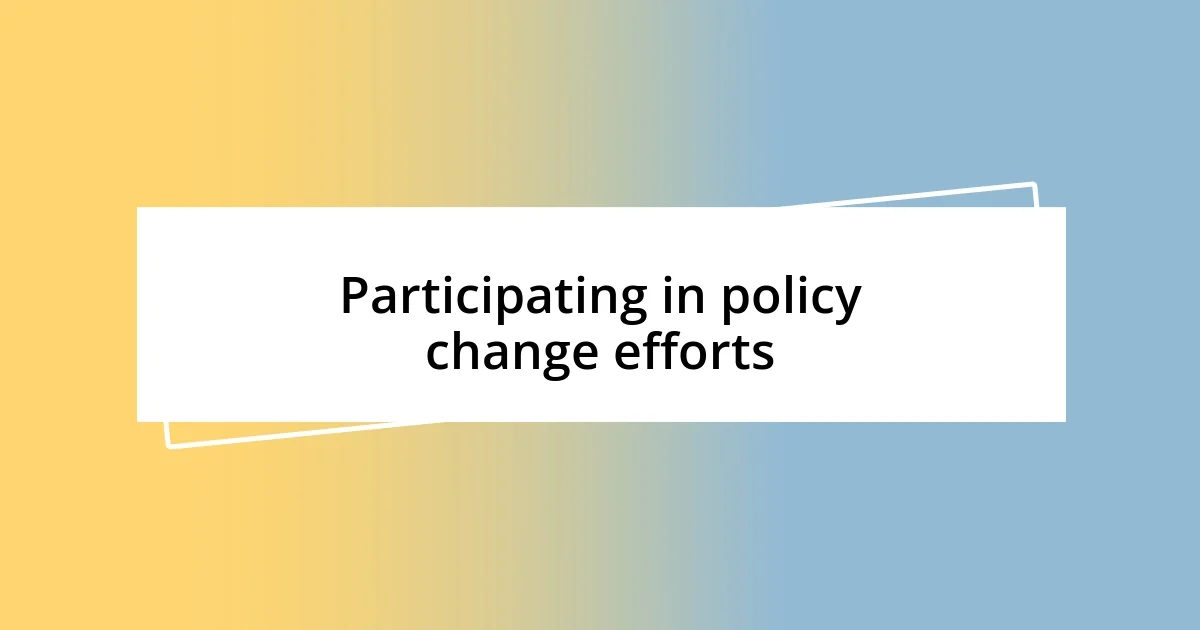
Participating in policy change efforts
Participating in policy change efforts is where I’ve found some of the most profound moments in my advocacy journey. I remember attending a rally advocating for stronger regulations on industrial emissions. There was a palpable energy as speakers shared their real-life struggles with pollution impacting their health. It struck me how critical it is to not only stand in solidarity but also push for institutional change that can lead to lasting improvements in our communities.
Collaboration with lawmakers is another avenue I’ve explored. Once, I participated in a strategy session with local officials to address environmental justice issues. I was deeply moved when community members shared their lived experiences. Their vulnerability transformed our conversation; suddenly, it wasn’t just policy — it became personal. I realized that these stories are the heart of effective policy change, as they humanize data and statistics, making them impossible to ignore.
In my opinion, attending public hearings can be a game-changer. I’ll never forget my first experience at one; the room was filled with passionate citizens voicing concerns about hazardous waste disposal in our neighborhood. The anxiety in the air was thick. Yet, amid the tension, I felt a spark of hope. Witnessing the community come together to demand accountability from elected officials reinforced my belief that our voices can indeed shift policies. So, how often do we overlook our own power in these spaces? Engaging in these efforts fuels a belief that our collective voices matter, creating a ripple effect that breeds change.
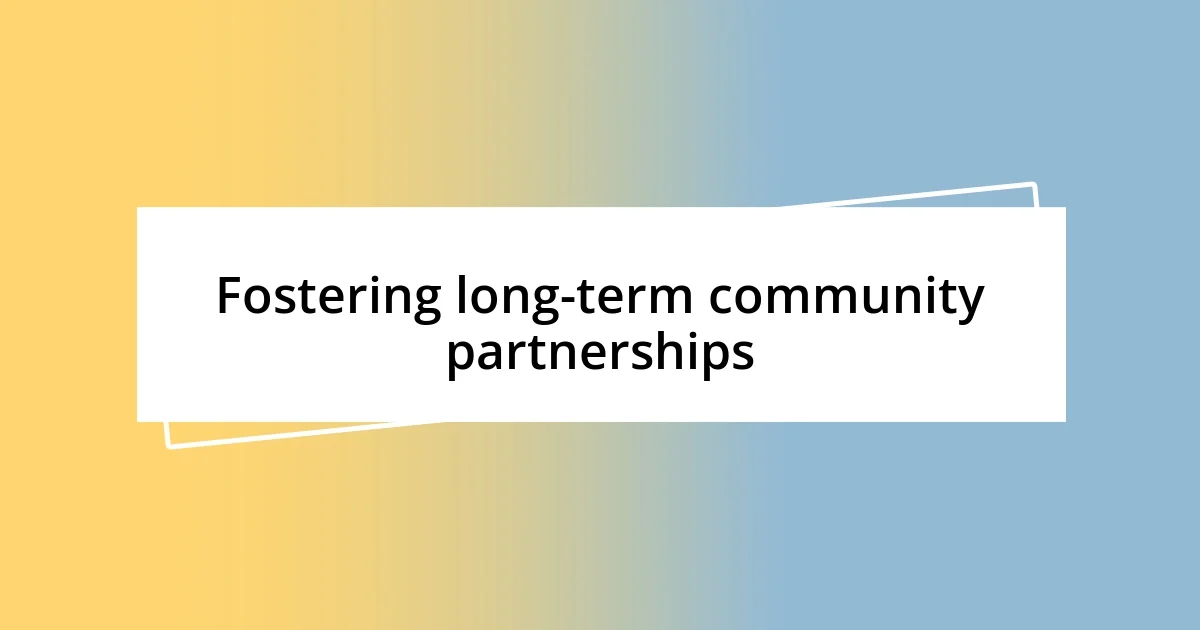
Fostering long-term community partnerships
Fostering long-term community partnerships carries immense potential for driving lasting change. I recall a vibrant community meeting where neighbors shared stories about their environmental struggles and triumphs. The energy was infectious, and I couldn’t help but think: what if we channeled this passion into sustainable collaborations? It’s in those moments that I realized how invaluable community ties can be when addressing the complex issues of environmental racism.
I’ve seen firsthand how building trust within communities leads to more resilient partnerships. During a neighborhood cleanup event, I struck up a conversation with a long-time resident who reminisced about how their family’s traditions of caring for local parks had faded. By working together, we not only beautified the area but reignited a sense of pride in stewardship. Isn’t it interesting how these small initiatives can spark wider interest and action? When community members feel ownership, it cultivates an environment where lasting change can flourish.
One of the most rewarding experiences I’ve had was partnering with youth organizations to create educational workshops. Watching young people take the lead was inspiring; their fresh perspectives and eagerness to learn reinvigorated my own commitment to this work. It made me ponder: how often do we underestimate the impact of empowering the next generation? These partnerships not only foster knowledge-sharing but also ignite a powerful passion for sustainable practices that can be carried into the future.












